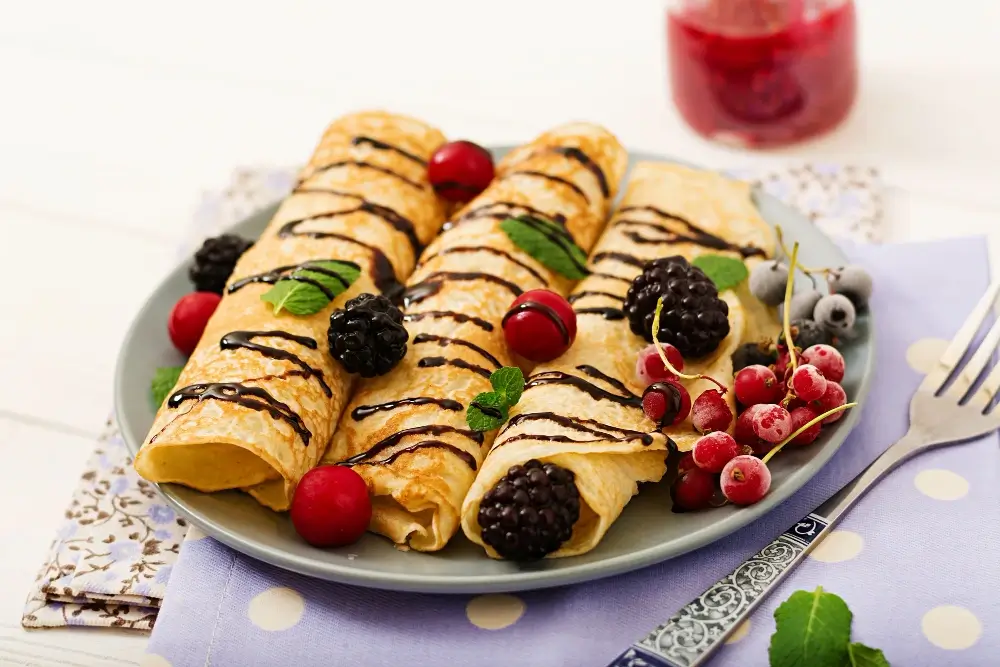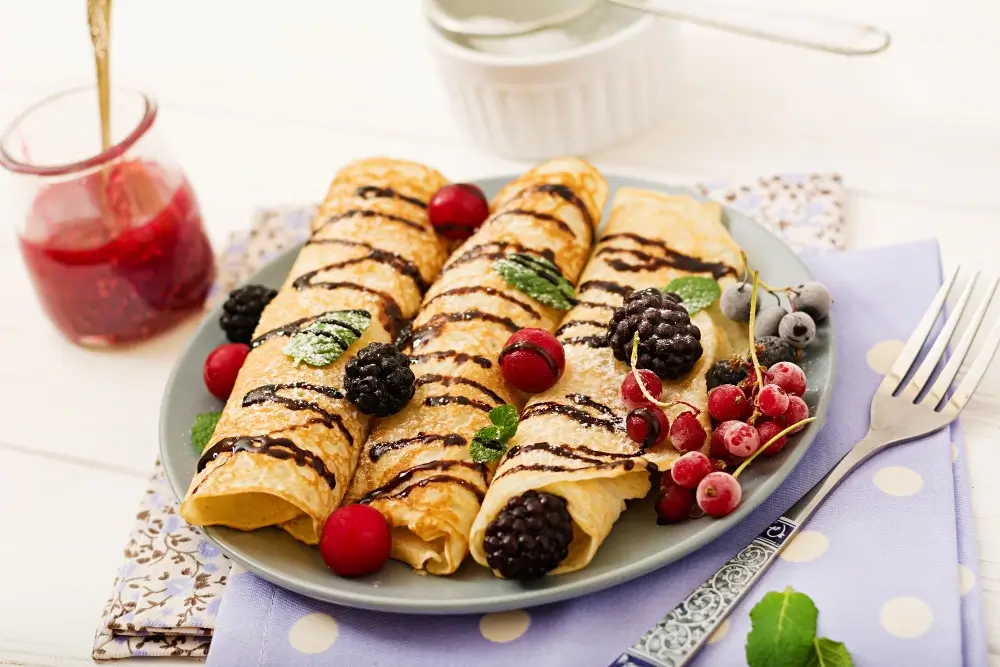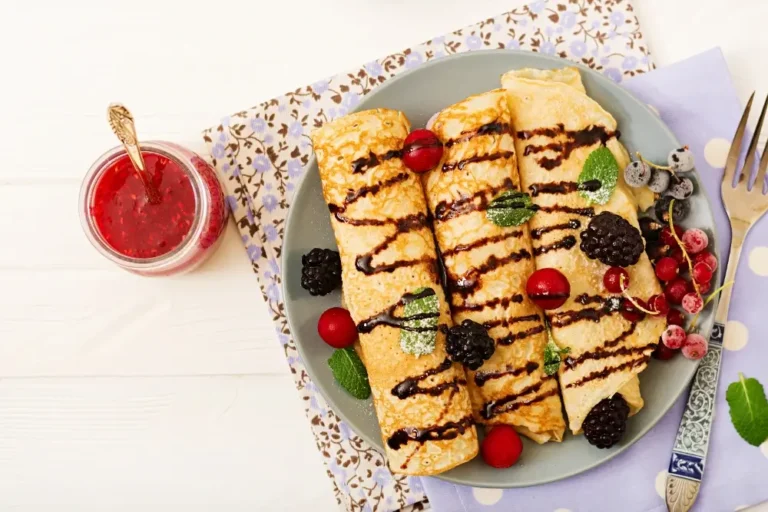Swedish pancakes are a delicious breakfast dish with a light texture and a slightly sweet flavor. These thin, crepe-like pancakes are perfect for pairing with a variety of toppings, from fresh fruit to whipped cream. Unlike American pancakes, which are fluffy and thick, Swedish pancakes feel delicate and easy to roll or fold.
For those who enjoy international recipes, Swedish pancakes offer an exciting twist to your morning meal. Explore other traditional breakfast dishes like Scandinavian cuisine recipes or compare them to fluffy pancakes made with Bisquick. Swedish pancakes bring something special to the table.
Why Swedish Pancakes Are Unique
authentic pannkakor, known as “pannkakor,” stand out for their soft texture and balanced sweetness. Cooks prepare them with a simple mix of milk, eggs, flour, and sugar. This high egg-to-flour ratio gives the batter a smooth consistency, resulting in a pancake that is pliable and easy to fill with sweet or savory options.
Although similar to French crepes, Swedish pancakes differ in flavor and preparation. They taste sweeter and feel softer, making them ideal for rolling or folding. Learn more about the differences between crepes and pancakes to appreciate their uniqueness fully.
A Brief History of Swedish Pancakes
Swedish pancakes have deep roots in Scandinavian culture. Centuries ago, they served as a simple yet nourishing meal during Sweden’s long, cold winters. Over time, they became a staple for special occasions and weekly traditions. Even today, many Swedes enjoy them on Thursdays with pea soup as part of a cherished custom.
Their light and versatile nature has made them popular worldwide. Modern brunch tables often feature authentic pannkakor, showcasing their adaptability and timeless appeal.
Making Swedish Pancakes
Ingredients for Swedish Pancakes
Swedish pannkakor require just a few simple ingredients, most of which you likely already have in your kitchen. Here’s what you need:
- Milk: Whole milk works best for a rich batter, but you can use alternatives like oat or almond milk for a lighter option.
- Eggs: They form the backbone of the batter, providing structure and flavor.
- Flour: All-purpose flour creates the perfect texture. For a gluten-free option, try a mix of almond and rice flour.
- Sugar: Adds a touch of sweetness to the batter.
- Butter: For richness and to prevent sticking during cooking.
- Salt: Enhances flavor and balances the sweetness.
By sticking to these essentials, you can create authentic Swedish pannkakor. For a guide on ingredient substitutions, check out easy pancake tips and recipes.
The Perfect Swedish Pancake Batter
Preparing the batter is simple, but following the right steps ensures great results:
- Combine Wet Ingredients: In a large mixing bowl, whisk together milk, eggs, and melted butter until smooth.
- Add Dry Ingredients: Gradually sift in the flour, sugar, and salt. Whisk continuously to prevent lumps.
- Let It Rest: Allow the batter to sit for 15–20 minutes. This step hydrates the flour and helps create a smoother texture.
The result is a silky batter ready for cooking. Avoid overmixing, as this can lead to a dense pancake. For more insights on making the perfect batter, visit our pancake preparation guide.
Cooking Techniques for Swedish Pancakes
Cooking Swedish pannkakor requires a gentle hand and attention to detail. Here’s how to do it:
- Preheat the Pan: Use a nonstick skillet or a specialized crepe pan. Heat it over medium heat and add a small amount of butter.
- Pour the Batter: Scoop about 1/4 cup of batter onto the pan. Tilt and swirl to spread it into a thin layer.
- Cook and Flip: Cook for 1–2 minutes until the edges lift easily. Flip carefully and cook for another minute on the other side.
- Repeat: Continue with the remaining batter, adding more butter as needed to prevent sticking.
Thin, golden pancakes are the goal. Mastering the cooking process takes practice, but the reward is worth the effort.
Tips for Success
- Maintain a consistent heat: Avoid cooking too quickly or burning the pancakes.
- Don’t overcrowd the pan: Work one pancake at a time for better control.
- Use a wide spatula: This makes flipping easier and reduces tearing.
Cooking Swedish pancakes becomes easier with practice. For more on tools and techniques, explore this pancake skillet review.
Swedish Pancakes vs. Crepes and Other pannkakor

Swedish pancakes often draw comparisons to other pancake varieties, particularly French crepes and American pancakes. However, subtle differences set them apart:
- Texture and Thickness:
- Swedish pancakes are thinner than American pancakes but slightly thicker than crepes.
- Their texture is soft and flexible, ideal for rolling or folding.
- Ingredients and Ratios:
- Swedish pancakes use more eggs and milk than flour, creating a smooth, pourable batter.
- French crepes lean toward a neutral flavor, while Swedish pancakes have a mild sweetness.
- Cooking Style:
- Both Swedish pancakes and crepes require a thin layer of batter spread across the pan.
- American pancakes, by contrast, are cooked thicker and fluffier.
Explore more about the differences between crepes and pancakes to deepen your understanding of these beloved dishes.
Norwegian Pancakes vs. Swedish Pancakes
Swedish pancakes share many similarities with Norwegian pancakes, or “pannekaker.” However, regional differences make each unique:
- Flavor:
- Norwegian pancakes are slightly less sweet, making them suitable for savory dishes.
- Swedish pancakes embrace a touch of sugar, enhancing their sweet profile.
- Serving Style:
- Both types are served with similar toppings, like berries, jam, or whipped cream.
- Norwegians often enjoy their pancakes with brunost (brown cheese), a traditional Scandinavian treat.
- Cultural Significance:
- While both are Scandinavian staples, Swedish pancakes have stronger associations with weekly traditions like “Thursday Pancakes.”
Both varieties highlight the simplicity and charm of Scandinavian cooking. For more on traditional dishes, check out authentic Swedish cuisine.
The Versatility of Swedish Pancakes
Swedish pannkakor adapt to a variety of tastes, making them a global favorite:
- Sweet Options:
- Fill with jam, whipped cream, or Nutella for a dessert-like experience.
- Top with fresh fruit like strawberries or blueberries for a lighter touch.
- Savory Variations:
- Roll with smoked salmon, cream cheese, or spinach for a hearty meal.
- Pair with mushrooms and cheese for a rich, umami-filled dish.
Swedish pancakes prove their versatility by catering to every palate, whether you prefer sweet indulgence or savory satisfaction.
Frequently Asked Questions (FAQs)
What Is the Difference Between a Swedish Pancake and a Regular Pancake?
Swedish pancakes differ significantly from regular American pancakes. They are thinner, softer, and more pliable, resembling crepes. Regular pancakes are fluffy and thick, thanks to baking powder or soda in the batter. Swedish pannkakor rely on a higher egg-to-flour ratio, which creates their delicate texture. This difference makes authentic pannkakor ideal for rolling or folding with various fillings.
What Are Swedish Pancakes Made Of?
Swedish pannkakor are made with a simple mixture of milk, eggs, flour, sugar, butter, and salt. The batter is light and smooth, which contributes to their unique texture. For a gluten-free twist, you can substitute all-purpose flour with almond or rice flour without compromising the flavor.
What Is the Difference Between French and Swedish Crepes?
Although Swedish pancakes and French crepes look similar, they differ in several ways:
- Thickness: Swedish pannkakor are slightly thicker than crepes.
- Flavor: Swedish pannkakor have a sweeter flavor profile, while crepes are more neutral, allowing for both sweet and savory fillings.
- Batter Composition: Swedish pancake batter includes a higher ratio of eggs and milk compared to flour, resulting in a softer texture.
For more details, you can explore the differences between crepes and pancakes.
Swedish Pancakes vs. Crepes
While both are thin pancakes, Swedish pancakes are sweeter and softer than crepes. Their flavor and texture make them distinct, offering a melt-in-your-mouth experience.
Norwegian Pancakes vs. Swedish Pancakes
Both pancakes share a Scandinavian heritage but differ slightly:
- Sweetness: Swedish pancakes are sweeter, making them a popular dessert choice.
- Serving Traditions: Norwegian pancakes are often paired with brunost (brown cheese), a savory option rarely seen with Swedish pancakes.
How to Make Fluffy Swedish Pancakes?
To make fluffy authentic pannkakor:
- Whisk the ingredients thoroughly to create a smooth batter.
- Let the batter rest for 15–20 minutes. This step allows the flour to hydrate fully.
- Use a nonstick pan and cook on medium heat for even cooking.
For additional tips, check out our step-by-step guide.
What Are the Ingredients for Authentic Swedish Pancakes?
Authentic Swedish pannkakor use basic pantry ingredients: milk, eggs, flour, sugar, butter, and a pinch of salt. These ingredients create a batter that delivers the perfect balance of sweetness and texture.
Can You Use a Swedish Pancake Mix?
Yes, Swedish pancake mixes simplify the preparation process. They often contain pre-measured ingredients, so you only need to add milk, eggs, or butter. However, making them from scratch allows for greater control over flavor and texture.
What’s the Best Way to Serve Swedish Pancakes?
Swedish pannkakor are best served warm, topped with jam, fresh berries, powdered sugar, or whipped cream. Savory options include smoked salmon, sour cream, or sautéed mushrooms.
How Are Swedish Pancakes Stored?
To store Swedish pancakes:
- Place them in an airtight container in the refrigerator for up to three days.
- Reheat in a skillet or microwave to preserve their texture.
Best Swedish Pancake Mix Brands

If you’re short on time or looking for convenience, Swedish pancake mix can be a great option. These mixes often include all the dry ingredients you need, saving you the trouble of measuring and mixing. Some popular brands include:
- Krusteaz Swedish Pancake Mix: Known for its authentic flavor and easy preparation.
- IKEA Swedish Pancake Mix: A budget-friendly option that offers a traditional taste.
- Bob’s Red Mill Gluten-Free Mix: Perfect for those with dietary restrictions.
Using a premade mix can streamline your cooking process while delivering delicious results. For more details on pancake-making essentials, check out pancake tips and recipes.
Incorporating Swedish Pancakes Into Your Breakfast Routine
Swedish pannkakor are versatile enough to fit into any breakfast menu. Their light texture and mild sweetness make them a delightful alternative to traditional breakfast options. Here’s how you can incorporate them into your routine:
- Weekend Brunch: Pair with fresh fruit and a mimosa for a luxurious weekend spread.
- Quick Weekday Breakfast: Prep the batter the night before for a quick morning meal.
- Special Occasions: Serve as part of a festive brunch with toppings like whipped cream and berries.
Swedish pancakes are a wonderful way to elevate your breakfast game while exploring Scandinavian cuisine.
Why You Should Try Swedish Pancakes
Swedish pancakes bring together simplicity, flavor, and tradition. Whether you’re exploring new breakfast ideas or embracing international dishes, they are a perfect addition to your recipe collection. Their versatility allows you to enjoy them in countless ways, from sweet to savory.
If you’re ready to try authentic pannkakor, start with an authentic recipe or experiment with unique fillings and toppings. For further inspiration, visit traditional Scandinavian cuisine recipes or dive into authentic Swedish cooking.
Final Thoughts
Swedish pannkakor are more than just a breakfast item; they’re a taste of Scandinavian culture. By incorporating these light, delicate pancakes into your meals, you can experience the joy of a classic recipe that has stood the test of time. Whether you make them from scratch or use a mix, pannkakor are sure to become a favorite in your kitchen.

